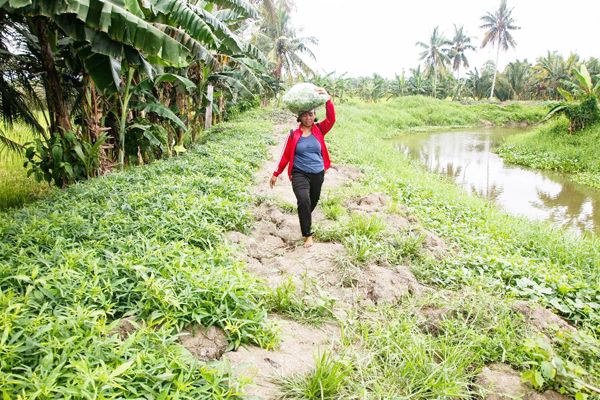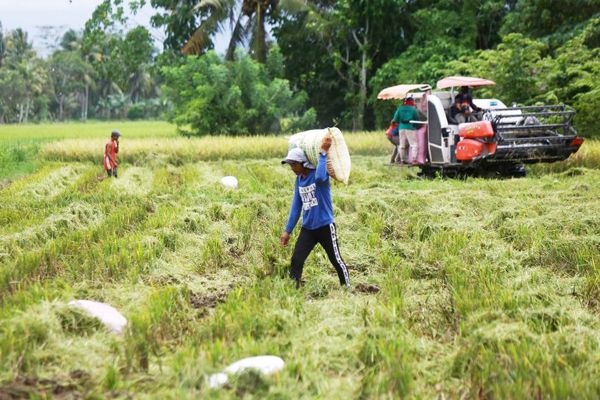CARMEN, Davao del Norte – Eight months after the severe flooding that devastated thousands of hectares of agricultural land, farmers here are now in the recovery period for this harvest season that started this month.
But as perennial flooding and dry spell remain as a threat to farmers’ production, agriculturists are encouraging farmers to adapt and diversify to mitigate the impact of natural calamities.
Thousands of hectares of agricultural land were devastated following severe flooding spawned by heavy rains hit the low-lying towns of this province.

FARMER Rhea Geroche carries a bag of freshly harvested alugbati on her head in Barangay Ising, Carmen Davao del Norte. (Keith Bacongco)
Municipal Agriculture Office chief Lionila Quiblatin said that most of the farmers in this town are now in their recovery phase.
Farmers in other areas that were not affected by the flooding were able to harvest in March, Quiblatin said.
Quiblatin said while hundreds of hectares of rice fields were submerged in the flooding, many farmers were able to replant after the flooding.
But she said that some areas were not able to replant due to lack of access to water after a portion of the irrigation dike was damaged during the flooding.
Some were farmers who were not able to replant due to lack of financial capacity when their crops were destroyed in the flooding last February, she added.
“Harvest season has just started and we are still on target to produce at least five metric tons of palay (unhusked rice) per hectare,” the agriculturist said.
Despite the perennial flooding, Quiblatin said that this municipality remains food sufficient since there are still rice-producing barangays that are not prone to flooding.
In the neighboring town of Braulio Dujali, chief agriculturist Joey Ariola also said that the farmers are recovering from the impact of flooding.
Ariola added that many of the farmers have also started to harvest palay as most of them were able to replant after the flood affected 2,000 hectares of rice farms last February.
Among the farmers in Braulio Dujali who had just harvested his palay farm was Mario Mandigal, a certified rice seed grower.
However, he only got 70 sacks from a hectare of his rice farm. “It was slightly hit by an infestation that’s why I got lower yield this time.” In the past, he was averaging at least 100 bags per hectare.
Like their neighboring town, Ariola is confident that they could still achieve the minimum target of at least four metric tons of palay per hectare this harvest season.
“While many of our farmers suffered huge losses in the flooding, they are now in the recovery phase this harvest season.”
Data from the Philippine Rice Research Institute in Laguna province showed that both towns produce an average of at least five metric tons of palay per hectare as of 2023.
Flood prone area
Both of these towns serve as the catch basin of the river systems that flow from the mountainous areas of this province.
While it is also one of the main sources of irrigation, the Liboganon River has also been the cause of flooding in low-lying areas during the rainy season.
Aside from this town, the river cuts across the city of Tagum and the towns of Asuncion, Braulio Dujali, and Kapalong. When it overflowed last February, floodwater submerged all of the villages on its banks.
While the provincial government is regularly desilting the Liboganon River and other waterways, Quiblatin said flooding could still occur due to the volume of water brought by heavy rains in the mountains.
She added that the local government is eyeing to put up pumping stations in strategic areas to mitigate the flooding in the future.
The flooding last February was the worst to hit this province as portions of the national highways connecting other parts of the province were temporarily impassable even to big trucks.
She admitted that the local government alone cannot address the perennial flooding. “It must be a comprehensive approach because the other towns should also implement mitigating measures since they are also part of the river systems that are causing the flooding,” she said.
Based on the February 18 report of the National Disaster Risk Reduction and Management Council (NDRRMC), damage and losses to agriculture in this town was estimated to be at least P4 million.
Braulio Dujali recorded the highest damage and losses in the province with P12.8 million and the NDRRMC reported the province logged an estimated P29.9 million in damage to agriculture.
Adapt and diversify
Both seasoned agriculturists agreed that perennial flooding could be among the effects of climate change.
They encouraged farmers to adapt to the situation as well as diversify their farms to be able to survive when natural calamities strike.
Ariola said that they have proposed to farmers, in coordination with the National Irrigation Administration (NIA), to adjust cropping patterns in anticipation of flooding every December and January.
“Since I came here in 1998, I have observed that the area is flooded every December and January due to monsoon rains. Thus, we have suggested to the farmers to adjust the cropping pattern so that by the first week of December, everyone has already harvested. Therefore, there will be no damages if the flooding comes,” he said.
Quiblatin backed the suggestion of her fellow agriculturist, saying that the proposal is still pending before NIA, which is primarily responsible for the access and management of irrigation systems.
While their local governments are implementing mitigating measures, both agriculturists encouraged farmers to implement crop diversification.

FARMERS harvest palay in Barangay Cabayangan, Braulio Dujali, Davao del Norte. (Keith Bacongco)
Quiblatin said that the local government is also promoting climate-resilient crops to be able to adapt to the situation.
“We have been encouraging farmers to grow cash crops so that they will have an alternative source of income while waiting for their rice or corn to be harvested,” she said, citing common vegetables such as alugbati, kangkong, pechay, and sweet potatoes.
Ariola also said that they are encouraging farmers to maximize all available spaces by planting a variety of vegetables not just for additional income but also to ensure food security.
Diversified farm
In Barangay Ising here, 46-year-old Rhea Geroche cultivates a vegetable garden on top of an earthfill-made dike on the Lasana River.
Geroche emphasized that having a vegetable garden is a big help to their daily needs while waiting for their rice to be harvested. “While waiting for our rice to be harvested in at least three months, we are already earning from our vegetable garden every day.”
She added that their daily income from their vegetable garden has been sustaining the needs of their children in school.
Last February, Geroche recalled, over three hectares of their mature palay were destroyed in the flooding.
She lamented that they were supposed to harvest the palay in a few days when flood swamped the area.
Geroche’s rice farm, a rain-fed area, is separated by a five-foot high earthfill dike beside Lasana River. Thus, when the river overflowed, everything washed away, including the vegetable crops on top of the dike.
“We lost everything in the flood. We had no money to sustain the needs of our students,” she lamented.
A few weeks after the disaster, Geroche and her husband started to rebuild their vegetable garden since it was the fastest way to earn money again.
A part of the seeds to rebuild her garden was provided by humanitarian group Oxfam Pilipinas, which implemented emergency assistance to the flood-hit communities in the province in collaboration with Rural Development Institute of Sultan Kudarat (RDISK).
Geroche emphasized the importance of crop diversification, saying that it is vital for every farmer to survive in this time when climate is becoming unpredictable.
“When you have vegetables, you are earning everyday while waiting for the rice to be harvested. Besides, you will never know if your rice will be hit again when the storm comes. But aside from vegetables, we should also maintain even a few livestock.”
She said that having a vegetable garden ensures them of an ample supply of food at home.
Little by little, Geroche said, many of her fellow farmers are now getting back on their feet after the devastating flood.